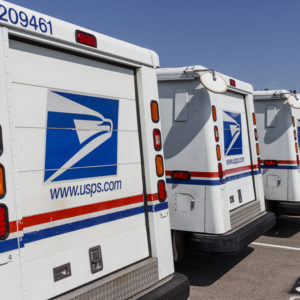The United States Postal Service (USPS) is going on a hiring spree. Government Executive senior correspondent Eric Katz reports, “[t]he U.S. Postal Service is planning to hire 100,000 employees in 2021, looking to fill vacancies that have contributed to logjams in the mailing agency’s network and widespread delivery delays.” Despite the recent unveiling of the initiative, the hiring campaign actually kicked off in January of 2021 and is expected to continue until January 2022. While it’s commendable that the USPS is trying to fix its logistical issues, the agency’s dysfunctional hiring process will result in some tough choices for America’s mail carrier. The USPS needs to get its other labor issues under control before getting more boots on the ground.
Most delivery companies follow predictable hiring patterns. Carriers such as UPS, FedEx, and Amazon massively ramp up seasonal help around the holiday time and whittle down their headcounts heading into the new year. For example, FedEx brought on 70,000 new workers for the 2020 holidays while UPS added about 140,000 workers to help give Santa a break. Typically, though, the USPS sticks to hiring between 35,000 and 40,000 seasonal workers.
The reason for the agency’s historic reluctance to take on holiday help is the pressure exerted on the USPS to limit the role of non-career workers and make temporary workers into career employees. Unions such as the National Postal Mail Handlers Union (NPMHU) and the American Postal Workers Union (APWU) confidently enter into negotiations with the USPS with full knowledge that, according to federal law, intractable impasses between unions and the USPS will automatically force the agency into a binding arbitration process. That means a mediator is all but certain to grant at least some concessions to the union, a process the APWU admits is friendlier to them than private-sector union-management standoffs.
Postal unions have used this unparalleled clout to make sure that non-career, lower-compensated USPS employees are shut out of key roles…unless the agency converts them to permanent employees. A 2019 agreement with the NPMHU shunned “casual” temporary employees from the Mail Handler craft, which entails loading, dumping, and preparing mail for delivery. This is even harsher than a 2016 agreement between the union and USPS, which capped the number of casuals in the craft at 3 percent. And when the USPS is forced to change the status of temporary workers to career employees, all of the financial benefits of hiring temps suddenly go out the window.
With the ongoing USPS hiring spree, Postmaster General Louis DeJoy believes he can get more temps on agency rolls by offering them more generous-than-usual benefits while culling those hires as needed via separation incentives and layoffs. This “switch on-switch off” approach to hiring appeals to DeJoy’s private sector instincts, and if successful, would make the USPS nimbler and more flexible like its private-sector competitors. But a large portion of these “temporary” hires will almost certainly become permanent, meaning that the USPS will have to spend more than the $40 billion envisioned for rebuilding the agency. Cost overruns are the last thing that the USPS needs right now. The agency has hemorrhaged more than $80 billion over the past 15 years, losing $9.2 billion in the past year alone.
Fortunately, Congress and the agency can act to ensure a successful USPS restructuring without breaking the bank. Lawmakers can start by revisiting the Postal Reorganization Act of 1970, which grants postal unions far-reaching negotiation and arbitration rights that don’t extend to other federal unions. Without unions having veto power over the USPS, agency officials would be free to hire the mix of career and temporary employees they see fit. Staffing would be able to reflect underlying demand for mail service, rather than the threat of binding arbitration.
The USPS should have the ability to go on a hiring spree without having to pass exorbitant costs along to taxpayers.

